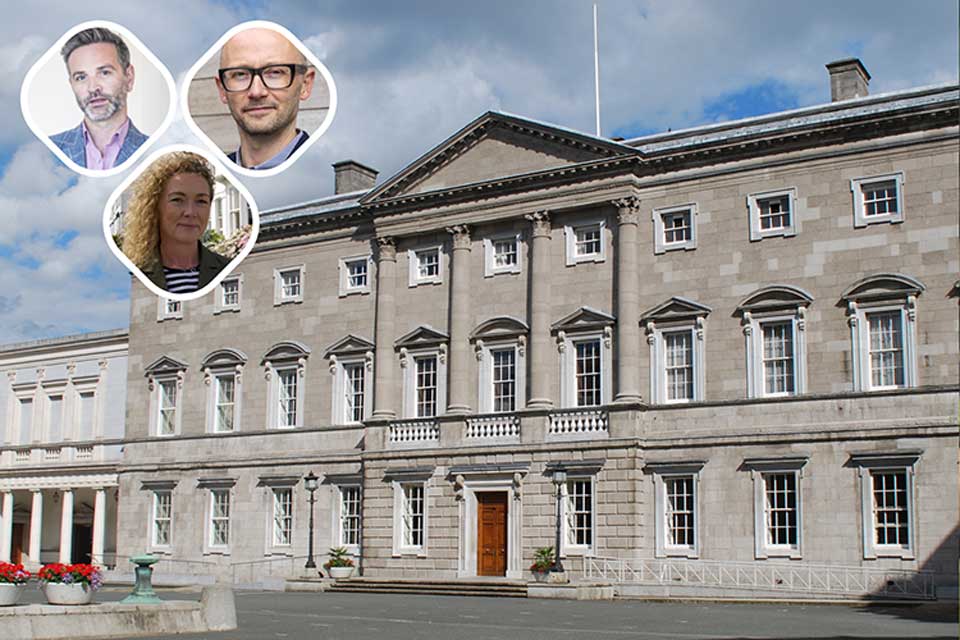News and Events
- UCD and Irish Space Association Join Forces to Drive New Partnerships in Ireland’s Growing Space Sector
- Six teams receive funding in second round of National Challenge Fund
- Staff shortages preventing environmental policy implementation in Ireland, study finds
- RIAI lifetime achievement award for UCD Professors Emeriti O’Donnell and Tuomey
- ESTEEM Graduate Programme 2025
- Congratulations to UCD’s Professor Eliana B. Souto and Dr Madhusanka Liyanage
- Frontiers for the Future: Minister Lawless announces €34.5M investment in cutting-edge research
- TrojanTrack wins One to Watch Award at UCD 2025 AI Ecosystem Accelerator
- ERC funding for research that could reduce the energy consumption of next-generation wireless networks by 50%
- Architecture through use, adaptation and shared maintenance
- Ireland risks breaching carbon budgets as Oireachtas committee hears calls to reuse vacant properties to meet climate and housing goals
- UCD leads new €1.5m project to restore native oyster reefs to strengthen coastal resilience
- €2m funding for gene therapy research led by UCD Professor Niall Barron
- 183 high-achieving students honoured at UCD Global Excellence Scholarships Event
- Groundbreaking MedTech device by UCD spin-out secures €6m in funding
- Ireland’s first satellite EIRSAT-1 completes its mission
- Research reveals the evolution of human bipedalism in two steps
- EIRSAT-1 successfully demonstrates advanced satellite pointing
- Minister Lawless announces 72 Sustainable Laboratory Certifications
- UCD UAV Team success at IMechE UAS Challenge
- UCD rises to 118 in latest QS World University Rankings
- Researchers to share discoveries at free public event in Dublin City Centre Sat 14 June
- Tánaiste announces the five teams to progress to the next phase of the Research Ireland-Defence Innovation Challenge programme
- Pilot study allowing children to identify road risks during school commute
- New funding award boosts Ireland-Wales research collaboration
- Engineers Ireland President’s Award for Professor Aoife Ahern
- LaNua Medical Receives 2025 NovaUCD Spin-out of the Year Award
- Inventors of Moveable Oral Sensor with Clinical Applications Receive 2025 NovaUCD Invention of the Year Award
- University College Dublin’s 2025 Innovation Awardees Announced by NovaUCD
- Minister Lawless announces €17.7 million research infrastructure investment
- Successful Demonstration of Hydrogen Innovation: RESR Technology Showcased on a Live Film Set
- Minister James Lawless announces over €6 million funding for final cohort of National Challenge Fund finalists
- €7 million joint investment announced for US-Ireland Research Programme
- New Double Degree in Sustainability Engineering Leadership
- Highlights of the recent College Research Culture Event
- Ten research projects funded to develop new technologies in the Defence Forces
- Minister Lawless announces €23.6 million Research Ireland Frontiers for the Future funding
- Brandon Blacoe, wins the GAConf top prize for Best assistive technology in the New or improved accessibility technology category
- Ulysses scheme funds 14 Ireland and France-based research collaborations
- CEA Strategy for Research, Innovation & Impact Launch Event
- Minister Lawless announces €2.5million for 28 Research Ireland industry-focused fellowships
- EIRSAT-1 wins UCD Research Impact Competition for transforming national space landscape
- Archives
Ireland risks breaching carbon budgets as Oireachtas committee hears calls to reuse vacant properties to meet climate and housing goals

Representatives of the Oireachtas have heard that Ireland risks overshooting its carbon budgets unless immediate measures are taken to reduce emissions in the construction sector.
Head of the UCD School of Architecture, Planning and Environmental Policy, (opens in a new window)Dr Oliver Kinnane, told the Oireachtas Committee on Climate, Environment and Energy that “much work is required” to balance continued construction with the need to meet national carbon targets.
“Construction is inherently carbon-intensive,” he said. “More buildings will add carbon emissions in the short-term through the emissions embodied in the materials they are constructed with and in the longer term through the life cycle of operation.
“Housing targets have increased from 33,000 per year to over 50,000. This increase will bring considerable additional embodied carbon as a result of the use of current methods of construction.”

Dr Oliver Kinnane, Head of the UCD School of Architecture, Planning and Environmental Policy
Presenting research funded by the Sustainable Energy Authority of Ireland (SEAI), Research Ireland and the European Commission, Dr Kinnane said Ireland had already slightly exceeded its first carbon budget period of 2021 to 2025, but in the next five years was forecast to overshoot its second carbon budget by 20% to 25%.
These carbon budgets are legal limits on the total amount of greenhouse gases that can be emitted over five-year periods.
In construction, some two-thirds of these emissions are operational in nature, and one-third are the embodied carbon emissions associated with building, maintenance, and demolition.
With 300,000 homes and associated infrastructure expected to be built in the next decade, the committee heard that under current housing delivery methods, any carbon reductions due to increased operational efficiencies would be cancelled out by the emissions associated with the construction of these homes.
“We need to save the buildings we have and retrofit first. We need to legislate to limit unnecessary demolition,” said Dr Kinnane, outlining key recommendations that included transiting to more resource-efficient buildings and infrastructure, the use of modern methods of construction, such as prefabricated units and 3D printing, and updates to existing regulations to enable greater use of timber and innovation in concrete and bio-based construction materials.
Adding that the renovation and reuse of existing buildings “carries a fraction of the embodied carbon cost of new build”.
“Our modelling works show that retrofitting 100,000 of our vacant homes could slice over 1 megatonne of CO2 emissions off the embodied carbon bill to 2030. The reuse of existing buildings in existing cities, towns and villages is an opportunity to add to the housing stock where existing structures, infrastructure and services are already provided, saving more than 30% additional embodied carbon.”
On the reuse over new build to cut carbon emissions, Dr Kinnane’s recommendations followed on from a similar assessment heard by the Oireachtas Housing committee.

UCD Centre for Irish Towns Co-Director Orla Murphy, UCD School of Architecture, Planning and Environmental Policy
Invited to speak on vacant and derelict buildings, (opens in a new window)Orla Murphy and (opens in a new window)Dr Philip Crowe, from the UCD School of Architecture, Planning and Environmental Policy, and Co-Directors of the UCD Centre for Irish Towns, said that the reuse of such properties could address Ireland’s dual housing and climate crises.
"Today, we have a worsening housing crisis and a parallel urgent need to reduce carbon emissions within a rapidly closing window. Meanwhile, over 80,000 empty homes and an increasing number of vacant other buildings sit idle,” they said as part of their (opens in a new window)Opening Statement.
“This is a stock of buildings already connected to expensive water, drainage, energy, data and transport infrastructure. We need to shift from a national mindset of asset hoarding to one which values the limited resources of land and buildings, and makes more intelligent use of them.”
Ms Murphy said that 80,328 to 164,000 vacant and derelict residential properties exist in Ireland, and that while their reuse was an opportunity to help meet carbon targets, it also represented an opportunity to rejuvenate and regenerate communities.
“We know numerous towns in the west and Border counties where whole streets are still vacant and derelict, and they have been for years.
“These are places with history and heritage where people have lived and where people can live again. It is not just houses; it is all the buildings in our towns and urban environments.”

UCD Centre for Irish Towns Co-Director Dr Philip Crowe, UCD School of Architecture, Planning and Environmental Policy
Addressing the issue of data on vacancy and dereliction, Dr Crowe stated there is a need to shift the current focus on individual buildings to the urban block, but at present, the funding only exists at the scale of a building.
“We do not have programmes for revitalisation at the scale of a town. The funding is not there… If we look at a country like France, they have multiple programmes for the town centre, for small villages, and it is renewal at scale. We are just missing that.”
He further noted there are issues with current datasets from the Central Statistics Office and Geodirectory, as they are not comparable.
"They are measuring different things using different methods. There may be a lack of transparency around some of those methods, and we would question any data on vacancy.
“One of the things we're doing in UCD is we have a project funded by the National Challenge Fund. It is looking at a way to use technology and different data sets to try to understand the likelihood of vacancy much better. We are effectively mirroring a technique used in France, which is bringing a lot of proxy and real data sets into a GIS (Geographic Information System) and using AI to find the likelihood of vacancy. We believe that we will come up with some useful results.”
Adding: “We should be able to put together a data model that would give us a very good indication of the likelihood of vacancy, the type of vacancy, the condition of buildings and their energy efficiency so that we understand our built environment. At the moment, we do not understand our built environment because we do not have the data.”
Hosted by the UCD School of Architecture, Planning and Environmental Policy, the UCD Centre for Irish Towns brings together researchers and stakeholders from across the island of Ireland to support the revitalisation of Irish towns.
By: David Kearns, Digital Journalist / Media Officer, UCD University Relations
UCD College of Engineering and Architecture
Room 122 & Room 126, UCD Engineering and Materials Science Centre, University College Dublin, Belfield, Dublin 4, Ireland T: +353 1 716 1868 | E: eng.arch@ucd.ie | collegeea@ucd.ie | engarch.research@ucd.ie | Location Map(opens in a new window)All Student Emails should be submitted using our Engineering and Architecture Office Student Connector. This will ensure the fastest and most efficient reply to your email.